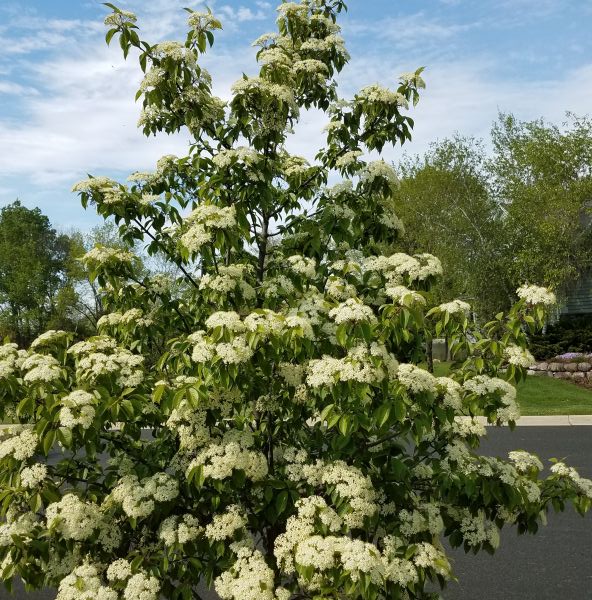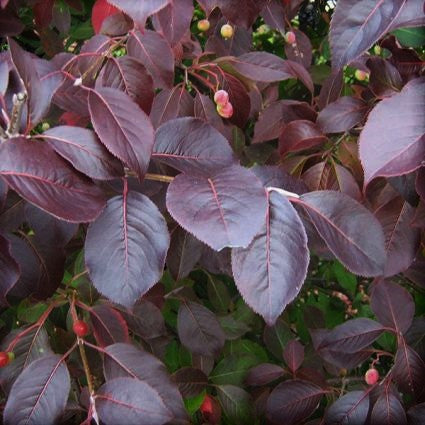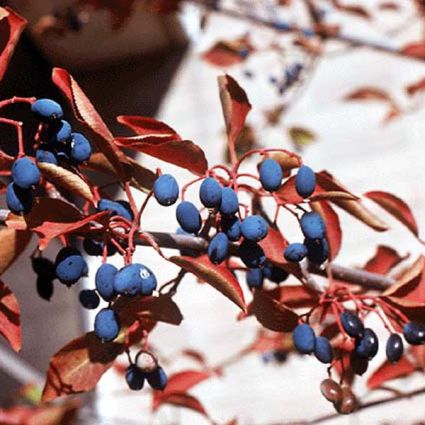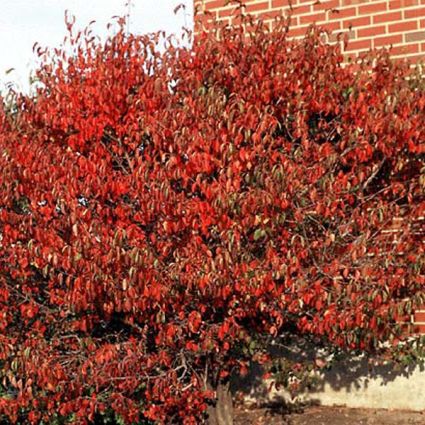Forest Rouge Blackhaw Viburnum
Viburnum prunifolium 'McKRouge'
- Stay Protected with Plant Sentry ™
Forest Rouge Blackhaw Viburnum - #3 Container is backordered and will ship as soon as it is back in stock.
Plant Sentry™
Plant Sentry™

Plant Sentry™ Protected
Your order is protected by our compliance system that:
- Prevents restricted plants from shipping to your state
- Ensures plants meet your state's agricultural requirements
- Protects gardens from invasive pests and diseases
Delivery and Shipping
Delivery and Shipping
Delivery and Shipping
Fast, Safe Plant Delivery
Ships in 3-4 business days • Tracking provided • Weather protected
| Under $50 | $9.99 |
| $50 - $99.99 | $14.99 |
| $100 - $149.99 | $16.99 |
| $150 - $198.99 | $24.99 |
| $199+ | FREE |
✓ Zone-specific timing • ✓ Professional packaging • ✓ Health guarantee
Understanding Plant Options
Nature Hills offers plants in two main formats:
- Container Plants: Grown in pots with soil, sized by container volume and plant age
- Bare Root Plants: Dormant plants without soil, sized by height measurements
Container Plant Sizes
Container sizes indicate plant age and growing capacity rather than liquid volume equivalents. Our containers follow industry-standard nursery "trade gallon" specifications, which differ from standard liquid gallon measurements.
Young Plants (6 months to 18 months old)
| Container Size | Actual Volume | Metric Equivalent |
|---|---|---|
| 2" x 2" x 3" | 0.18 - 0.21 dry quarts | 0.20 - 0.23 dry liters |
| 4" Container | 0.31 - 0.87 dry quarts | 0.35 - 0.96 dry liters |
| 4.5" Container | 0.65 dry quarts | 0.72 dry liters |
| 6" Container | 1.4 dry quarts | 1.59 dry liters |
| 1 Quart | 1 dry quart | 1.1 dry liters |
| 5.5" Container | 1.89 dry quarts | 2.08 dry liters |
Established Plants (18 months to 2.5 years old)
| Container Size | Actual Volume | Metric Equivalent |
|---|---|---|
| 2 Quart | 2 dry quarts | 2.2 dry liters |
| #1 Container | 2.26 - 3.73 dry quarts | 2.49 - 4.11 dry liters |
| 5" x 5" x 12" | 3.5 - 4.3 dry quarts | 3.85 - 4.74 dry liters |
Mature Plants (2-4 years old)
| Container Size | Actual Volume | Metric Equivalent |
|---|---|---|
| #2 Container | 1.19 - 1.76 dry gallons | 5.24 - 7.75 dry liters |
| #3 Container | 2.15 - 2.76 dry gallons | 8.14 - 12.16 dry liters |
Large Plants (3-5 years old)
| Container Size | Actual Volume | Metric Equivalent |
|---|---|---|
| #5 Container | 2.92 - 4.62 dry gallons | 12.86 - 20.35 dry liters |
| #6 Container | 5.25 - 6.01 dry gallons | 23.12 - 26.42 dry liters |
| #7 Container | 5.98 - 6.53 dry gallons | 26.34 - 28.76 dry liters |
Bare Root Plants
Bare root plants are sold by height from the root system to the top of the plant. Plants may exceed minimum height requirements.
Common Sizes:
- Trees: 1 foot, 2 feet, 3 feet, 4 feet, 5 feet, 6 feet
- Shrubs & Perennials: 1 foot, 18 inches, 2 feet
Important Notes
Container Volume Specifications
- Trade Gallon Standard: Our containers follow industry-standard "trade gallon" specifications established by the American National Standards Institute (ANSI Z60.1) for nursery stock
- Volume Variations: Actual soil volume may vary due to plant root systems and growing medium settlement
- Age Indicators: Container size primarily indicates plant age and maturity rather than liquid volume equivalents
Growing Conditions
- Plant size can vary based on variety and growing conditions
- Container size helps indicate plant maturity and establishment level
- Larger containers generally mean more established root systems and faster landscape establishment
Seasonal Availability
- Bare root plants are available seasonally when dormant
- Container plants are available throughout the growing season
- Specific varieties may have limited availability in certain sizes
Questions?
For questions about specific plant sizes or availability, please contact our plant experts who can help you choose the right size for your landscape needs.
Plant Highlights
Forest Rouge Blackhaw Viburnum highlights at a glance!
-
Botanical Name
-
Brand
-
Growing Zones4, 5, 6, 7, 8
-
Growth RateModerate
-
Mature Height
-
Mature Width
-
Leaf Color
-
Flower Color
-
Fall Color
-
NativeYes
-
Pollinator FriendlyYes
-
Pollinator Required
-
Bloom PeriodLate Spring
Characteristics
Where To Plant
When To Prune
- Late Spring
Water & Moisture Needs
- Moderate
Sunlight Needs
Soil Needs
- Widely Adaptable
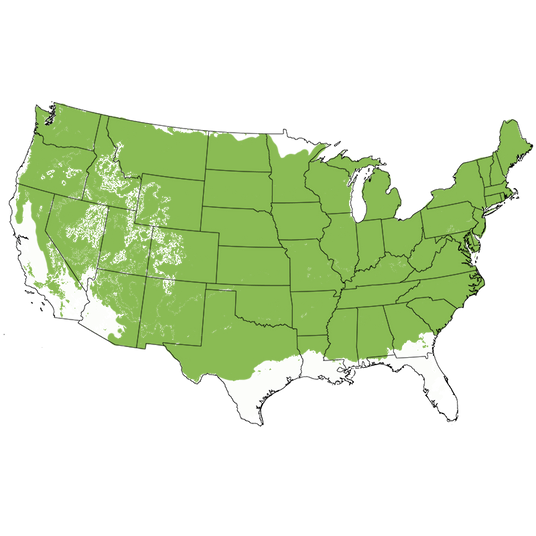
Growing Zones
Fall color in the shade is hard to come by! Often plants need full sun to bring out their strongest fall color. Not so with the Forest Rouge Blackhaw Viburnum (Viburnum prunifolium 'McKRouge')! It can develop a wonderful fall color display with only a few hours of sunlight a day.
The leathery, large leaves start out as beautiful yellow-green in the spring and age to dark, shiny green for summer. The new leaves gain a visual boost because of their showy young stems, which emerge dark red. You'll love the contrast!
Large clusters of creamy-white flat-topped lacy flowers appear in mid-spring and become fast pollinator favorites! They resemble the pretty, delicate Elderberry flowers, and butterflies adore them.
Over time, the flowers develop into handsome, bluish-black berries that hold on to the plant from fall until winter. That is if your local birds and other wildlife population doesn't strip them first. These plants are wonderful natural bird feeders and help support birds in your area. Called wild raisins, the mildly sweet fruit is high in Vitamin C and can be used by people too in preserves, sauces, and baked goods. Plant Forest Rouge with another Blackhaw Viburnum or Viburnum prunifolium variety for an increased fruit set!
Of course, you've probably studied the photos of that deep, delicious orange-red-to-purple fall foliage. It's one of the best displays available. Plus, it starts early and ends late! Some leaves start to show color in August, and they hold the deep maroon color late into the season. The exterior leaves are purplish, and the interior leaves turn very red. This shrub is highly recommended for showy fall foliage. It gives a dependable performance year after year that lasts a long time from late summer into fall.
Planting and Application:
The selection of this hardy native bush will happily show off in a partially shady corner of your garden. It will perform equally well in a sunny spot. You'll want to be sure to site it where you'll see it, either from the house or along the path to a special destination spot in your landscape.
This marvelous native shrub really has it all. Deep fall color, rugged good looks, delicate spring flowers for butterflies and honeybees, and built-in bird feed in autumn and winter. You'll feel great about including Forest Rouge Blackhaw Viburnum in your landscape.
Give it plenty of room to grow into its mature size and spread. This is a plant that looks best in a naturalized setting. For informal hedges and privacy screens, these colorful flowering ornamentals will add lush seclusion to your backyard retreats!
The Blackhaw berries are nicknamed Wild Raisin. These deep purple fruits are high in Vitamin C and full of carbohydrates. They'll definitely become a favorite for your local songbirds!
Include it with other Viburnum species as a very special mixed shrub border. Add Chickasaw Plum to support the needs of wildlife on your property. Introduce more berries for birds from Nature Hills collection of Aronia Chokeberry shrubs for an ornamental edible landscape!
Or, pair it with a grouping of Eastern Red Cedar, or Eastern White Pine trees. Its lavish fall tones truly pop near evergreen plants. Underplant the sunny side with smaller evergreens, such as Blueberry Delight Juniper. Or plant with another Viburnum prunifolium to significantly increase pollination and berries for your and your bird's enjoyment!
Commercial property owners, create foot traffic for your business with an application of earth-friendly plants, especially if you have a natural water feature like a creek running on the grounds. This tall shrub makes a dynamic mass planting and can be used to fill wide, open ground.
Be sure to advertise your landscape design choices with on-site plant identification plaques and a full description online. After all, customers are using their dollars these days to show appreciation for thoughtful corporations. Make a big splash with Forest Rouge Blackhaw Viburnum.
Plant 4 feet apart on center to create a solid screen. You'll measure from the center of one to the center of the next. Mulch newly installed mass plantings and keep them weeded until the plants grow to touch.
Another unique way to use these sculptural plants is as a standalone specimen. Try them in the center of a formal planting bed, outlined in sheared Boxwood hedging. This subtle play between formal edging and the freeform shape of your Blackhaw will give your landscape a very modern feel.
- Flat-Topped Clusters of Creamy White Flowers Appear in Mid Spring
- Edible Blue Black Fruit - Called Wild Raisins
- Outstanding Maroon Fall Color Lasts & Lasts
- Pollinator & Bird Friendly!
- Hardy Native Cultivar With An Oval Upright Form
- Excellent Hedge or Low Screen, Specimen & Fall Color Accent
#ProPlantTips for Care:
Forest Rouge Blackhaw will excel in partial shade or full sun. They require at least 4 hours of sunlight to produce the best fall color. Ensure the planting site is well-drained. This Viburnum is adaptable to a variety of soil types, from sandy loam to clay, as long as they drain well. You can also plant in a raised bed, or mounded heap of soil brought in to a level of 18 inches above your soil. Plant directly in that mound to improve drainage.
Give new plants a moderate amount of water on a regular basis. Once their roots are established in your soil, they are more resilient. However, if you have an extended dry period without rainfall, be sure to soak the ground all around the plant. Cover the root system with a thick layer of mulch to conserve moisture and extend the time between watering.
Prune to shape after the spring flowers but you'll miss out on the fruit. Instead, you can periodically renewal prune your shrub by cutting out the thickest, oldest stems from the base of the plant to rejuvenate it. Have care when doing this, as you want to ensure a balanced canopy will remain. Trim any suckers that emerge from the roots in early spring if you prefer or allow them to expand your planting over time.
In an average year that sees normal deer pressure, this variety is Deer resistant, but hungry deer may take a nibble, so we do always recommend using Deer Repellent Spray on all new plants and reapply according to the directions.
- Grows in Full Sun or Partial Shade
- Moderate Moisture Needs
- Appreciates Enriched Well-Drained Soil & Mulched Beds
- Deer Seem to Leave This Plant Alone
- Pollinate With Other Viburnum prunifolium Varieties
- Juglone and Deer Resistance
- Prune After Flowering - Blooms on Old Wood
This spectacular native cultivar should be strongly considered to grace your landscape all year long. Order your Forest Rouge Blackhaw Viburnum from the expert growers at Nature Hills today and get started enjoying it this year!
Frequently Asked Questions
Are Viburnum Bushes Fragrant?
The flowers on the Forest Rouge Blackhaw Viburnum have a slight pleasant scent.
Does Forest Rouge Blackhaw Viburnum Produce Fruit?
The Forest Rouge Blackhaw Viburnum will produce some fruit on its own, but two plants are needed for cross-pollination. Try another Blackhaw Viburnum variety planted nearby.
Does Forest Rouge Blackhaw Viburnum Spread?
Forest Rouge Blackhaw Viburnum can occasionally form suckers at the base of the plant, but these can be removed when pruning after flowering or mowed down if you do not wish it to spread. Not invasive, these plants will politely form tidy thickets over time when allowed.
Do Viburnum Shrubs Lose Their Leaves in Winter?
Forest Rouge Blackhaw Viburnum is a deciduous Viburnum and will drop its leaves in the fall.
How tall is a Forest Rouge Blackhaw Viburnum?
The mature height of a Forest Rouge Blackhaw Viburnum in optimal conditions is 8-10 feet, with a mature spread of 6-8 feet wide.
Will Forest Rouge Blackhaw Viburnum grow in shade?
The Forest Rouge Blackhaw Viburnum can grow in full sun and partial shade, for the strongest growth, and best color, plus for more flowers and fruit, provide at least 5-6 hours of sun a day. These will not do well in full shade.
Are Forest Rouge Blackhaw Viburnum berries poisonous to dogs?
There are no Viburnum dentatum varieties listed on the ASPCA website for dogs as being toxic or poisonous. As always, know your pets and monitor your pets when they're outside, even if one animal is not sensitive to a plant or berry, that doesn't mean there is no possibility of another not having an allergy or having a reaction.
How do you care for a Blackhaw Viburnum Forest Rouge?
These are incredibly easy-care shrubs that need full sun or partial shade in a well-drained, moderately moist environment. Well-drained enriched soil and mulched beds are preferred.
What Shipping Options Do You Offer?
NatureHills.com works closely with our growers and nursery professionals to ensure we ship when it is most appropriate for your area. Our goal is to deliver the hardiest plants by avoiding extreme high and low temperatures. Check out our shipping schedule for more information and to learn our wills and won'ts when it comes to shipping plants. Find your Viburnum for sale here at NatureHills.com!

